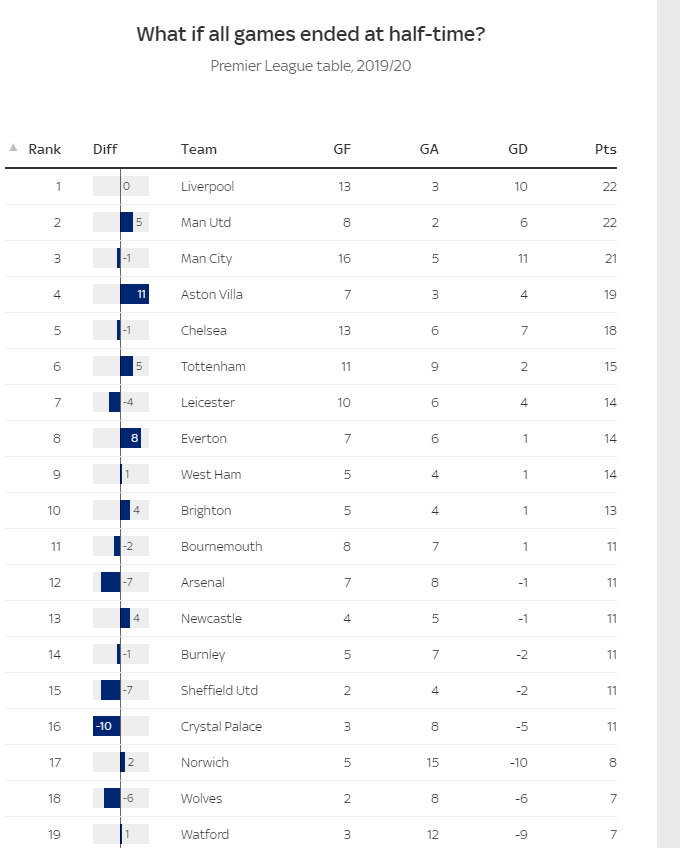Ways to avoid solutions to problems that don't exist
Aston Villa and the second-half switch-off.
Hey! Our free October preview ends in TWO DAYS! If you don’t want to miss a post going into November:
When playing ‘what if’ moves from fun to stupid

So Sky Sports has these nifty ‘Alternative Premier League Tables’, on what the league would look like based on xG and non-penalty goals only, that sort of thing. It’s fun! Thought-provoking, I guess!
But one table, in particular, caught the eye of a few fans on an Aston Villa forum the other day (not linking to preserve my online anonymity)—the current 2019-20 Premier League as it would look if only first halves counted.

It turns out, if you lop off the second 45 minutes from all of the first 10 matches of the season, Aston Villa would be in fourth place!
Admittedly, Villa have looked quite poor in finishing out a few of their matches; mediocre second-halves against clubs like Crystal Palace, West Ham and Arsenal have been frustrating to watch.
But the half-time table is being discussed by Villa supporters as some sort of conclusive proof that Aston Villa has trouble finishing out games, moving beyond the vague sense that something is wrong to thinking they’ve found evidence something is wrong.
Most of you will know this is already a silly exercise. But the fact that otherwise normal people—even paid football people with power and influence—will still look at these sorts of statistical baubles and draw conclusions, and even worse, take action based on those conclusions, means it’s worth discussing exactly why this table is not really ‘proof’ of anything.
Why? Villa are currently on 11 points, but if their first-half results would have put them on 19! You’re telling me that’s not proof something’s not right with the club?
First, the cutoff itself—50% of the games—is enormous. Within a ten-match span, there is more than enough random variation to explain any reversal in fortune, even to the tune of an 8-point difference in the table. Football isn’t 45 minutes, it’s 90! A lot can happen in the second half! And maybe Villa were lucky to be up in the first half in the first place! Maybe we’ll all find that out the hard way as this season progresses.
But you can’t make that claim unless you look at the actual matches! Eight points is still quite a lot to drop in the second half!
A brief glance at the table reveals that of the 10 games played this season, Aston Villa dropped points in the second half in 5 of them. That sounds like a lot!
But of those matches, 3 were drawn at half time, two nil-nils and one 1-1. Of the two games Villa were leading at half time and gave up points, the score was 1-0 for Villa in both and only one turned out to be a loss, against Arsenal. Even Sky’s halftime table itself shows that their first-half GD is a paltry 4 compared to 11 for Man City and 10 for Liverpool. So it’s not as if Villa had things on lockdown heading into the dressing room at halftime and then shit the bed.
But Villa seemed to have given up loads of second-half goals.
Yes, of Villa’s 16 goals conceded this season, 11 have come in the second half. Not good! But 8 of their 15 goals also came in the second half. So their second half GD is a not exactly devastating -3. Considering we’re only ten matches into the season, this difference in first-half vs second-half GD for Villa is not really big enough to be alarming or a sign of pretty much anything.
Perhaps, but it still seems like they’ve conceded late.
Of the 11 second-half goals Villa have conceded, 4 have come in the final 15 minutes. Two of these were against Arsenal, which WAS a disappointing collapse, particularly as Arsenal were a man down. But on the other hand, Villa have also scored 5 goals in the final 15 minutes, and two of those were deep in extra time! One was a match-winner, albeit against a team with ten-men.
Fine, fine, but I know what my eyes are telling me!
Your eyes are indeed seeing Villa cough up points in the second half of matches. What they are not able to tell you is whether this is a sign of Villa ‘switching off’—and not in a couple of matches, mind you, but as a rule—or whether this is just a matter of random variation in when in the game the ball is going in the net.
What’s your point, exactly?
This may seem like a pedantic exercise, but I know enough about a lot of clubs to know that when it comes to evidence gathering, a lot of managers still think like fans (hopefully Dean Smith doesn’t).
Some are more than willing to make drastic decisions based on little more than things like the Sky Sports table, such as rejigging second half tactics or substitutions or whatever—solutions that may be solving a problem that isn’t really a problem and may make things worse!
It may, in fact, be the case that Villa has an actual problem closing out games. But to determine that, you need far better information. Is xGD wildly inverted for Villa in the second half? Are there marked signs of player fatigue?
All I’m asking is that when you see these sorts of things shared around, to just take a few minutes to pore over the supposed ‘evidence’ being presented.


